The Apple iPhone 11, 11 Pro & 11 Pro Max Review: Performance, Battery, & Camera Elevated
by Andrei Frumusanu on October 16, 2019 8:30 AM ESTSystem & ML Performance
Having investigated the new A13’s CPU performance, it’s time to look at how it performs in some system-level tests. Unfortunately there’s still a frustrating lack of proper system tests for iOS, particularly when it comes to tests like PCMark that would more accurately represent application use-cases. In lieu of that, we have to fall back to browser-based benchmarks. Browser performance is still an important aspect of device performance, as it remains one of the main workloads that put large amounts of stress on the CPU while exhibiting performance characteristics such as performance latency (essentially, responsiveness).
As always, the following benchmarks aren’t just a representation of the hardware capabilities, but also the software optimizations of a phone. iOS13 has again increased browser-based benchmarks performance by roughly 10% in our testing. We’ve gone ahead and updated the performance figures of previous generation iPhones with new scores on iOS13 to have proper Apple-to-Apple comparisons for the new iPhone 11’s.

In Speedometer 2.0 we see the new A13 based phones exhibit a 19-20% performance increase compared to the previous generation iPhone XS and the A12. The increase is in-line with Apple’s performance claims. The increase this year is a bit smaller than what we saw last year with the A12, as it seems the main boost to the scores last year was the upgrade to a 128KB L1I cache.

JetStream 2 is a newer browser benchmark that was released earlier this year. The test is longer and possibly more complex than Speedometer 2.0 – although we still have to do proper profiling of the workload. The A13’s increases here are about 13%. Apple’s chipsets, CPUs, and custom Javascript engine continue to dominate the mobile benchmarks, posting double the performance we see from the next-best competition.

Finally WebXPRT represents more of a “scaling” workload that isn’t as steady-state as the previous benchmarks. Still, even here the new iPhones showcase a 18-19% performance increase.
Last year Apple made big changes to the kernel scheduler in iOS12, and vastly shortened the ramp-up time of the CPU DVFS algorithm, decreasing the time the system takes to transition from lower idle frequencies and small cores idle to full performance of the large cores. This resulted in significantly improved device responsiveness across a wide range of past iPhone generations.
Compared to the A12, the A13 doesn’t change all that much in terms of the time it takes to reach the maximum clock-speed of the large Lightning cores, with the CPU core reaching its peak in a little over 100ms.
What does change a lot is the time the workload resides on the smaller Thunder efficiency cores. On the A13 the small cores are ramping up significantly faster than on the A12. There’s also a major change in the scheduler behavior and when the workload migrates from the small cores to the large cores. On the A13 this now happens after around 30ms, while on the A12 this would take up to 54ms. Due to the small cores no longer being able to request higher memory controller performance states on their own, it likely makes sense to migrate to the large cores sooner now in the case of a more demanding workload.
The A13’s Lightning cores are start off at a base frequency of around 910MHz, which is a bit lower than the A12 and its base frequency of 1180MHz. What this means is that Apple has extended the dynamic range of the large cores in the A13 both towards higher performance as well as towards the lower, more efficient frequencies.
Machine Learning Inference Performance
Apple has also claimed to have increased the performance of their neural processor IP block in the A13. To use this unit, you have to make use of the CoreML framework. Unfortunately we don’t have a custom tool for testing this as of yet, so we have to fall back to one of the rare external applications out there which does provide a benchmark for this, and that’s Master Lu’s AIMark.
Like the web-browser workloads, iOS13 has brought performance improvements for past devices, so we’ve rerun the iPhone X and XS scores for proper comparisons to the new iPhone 11.
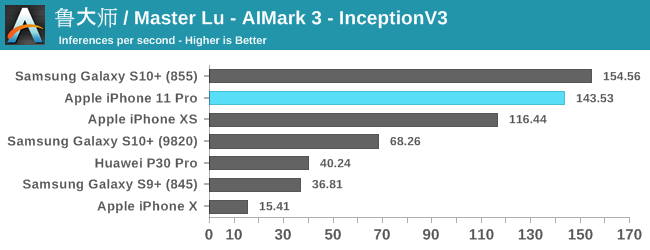
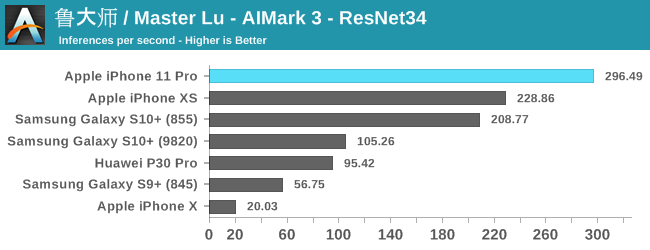
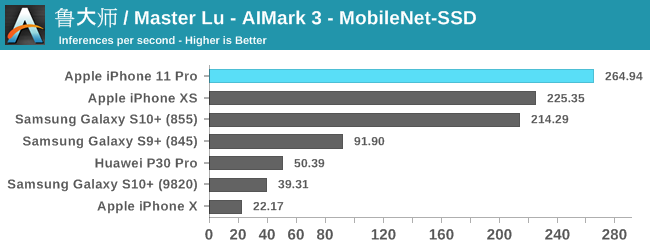
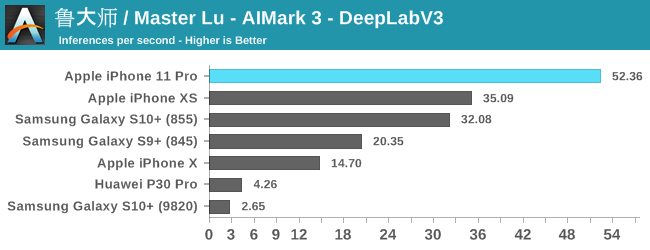
The improvements for the iPhone 11 and the new A13 vary depending on the model and workload. For the classical models such as InceptionV3 and ResNet34, we’re seeing 23-29% improvements in the inference rate. MobileNet-SSD sees are more limited 17% increase, while DeepLabV3 sees a major increase of 48%.
Generally, the issue of running machine learning benchmarks is that it’s running through an abstraction layer, in this case which is CoreML. We don’t have guarantees on how much of the model is actually being run on the NPU versus the CPU and GPU, as things can differ a lot depending on the ML drivers of the device.
Nevertheless, the A13 and iPhone 11 here are very competitive and provide good iterative performance boosts for this generation.
Performance Conclusion
Overall, performance on the iPhone 11s is excellent, as we've come to expect time and time again from Apple. With that said, however, I can’t really say that I notice too much of a difference to the iPhone XS in daily usage. So while the A13 delivers class leading performance, it's probably not going to be very compelling for users coming from last year's A12 devices; the bigger impact will be felt coming from older devices. Otherwise, with this much horsepower I feel like the user experience would benefit significantly more from an option to accelerate application and system animations, or rather even just turn them off completely, in order to really feel the proper snappiness of the hardware.


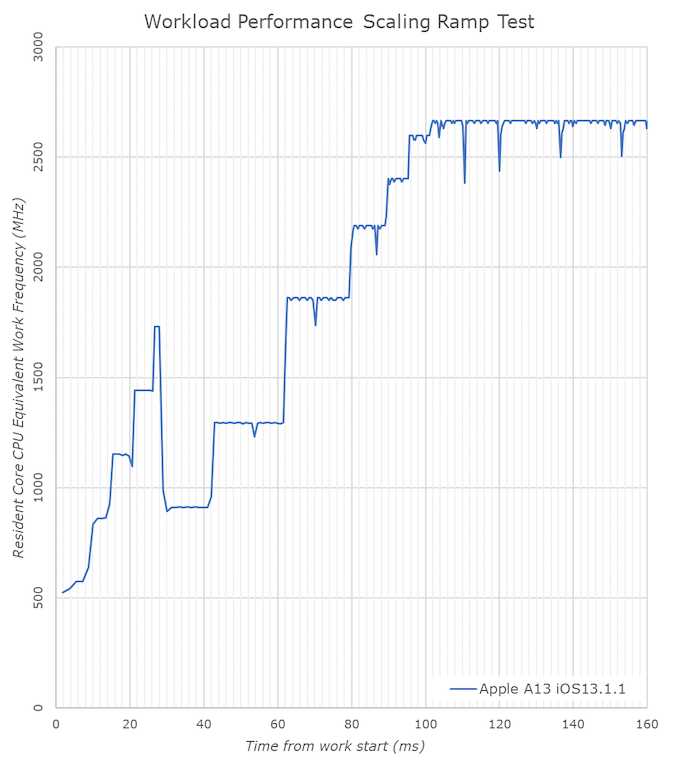








242 Comments
View All Comments
ksec - Wednesday, October 16, 2019 - link
Well At least one article got it right on Anandtech. Last time Anton refers Apple A13 as 7nm EUV, along with an TSMC update mentioning it as well. Now we can finally settle Apple is using N7P.I think one of the reason for the higher power usage is the A13 was designed with 7nm EUV in mind, and was only later changed to N7P as 7nm EUV may not provide enough capacity for Apple.
I do wonder if we are going to see 5nm Apple SoC next year.
Ian Cutress - Wednesday, October 16, 2019 - link
Anton didn't realise 'N7P' and 'N7+ with EUV' were different processes - and that people were using P instead of + for some unknown reason. Up until a while ago, any time someone said 'second generation N7', it was always thought of as N7+. Now we're making them clarify.FreckledTrout - Wednesday, October 16, 2019 - link
It's TSMC's alphabet soup so who can blame him. They could make the node names a bit easier for people whom are not CPU process nerds.dennphill - Wednesday, October 16, 2019 - link
Apple! They just give you what THEY want to! Pretty disappointed in all their products. I finally gave in and got rid of my Goggle thinggie (worthless, really) and got a reconditioned iPhone 8+ a coouple of months ago. It is really (so here's my technical user review: "It's just...") OK. My wife, OTOH, has an SE - her second - and she really doesn't want anything bigger. EVER! (Listen to that, Apple!) Even the reported new 'tiny' 2020 5.4" iPhone is what she calls HUGE. Weekend project is replacing her iPhone 5 SE battery that's begun not to keep a charge.peevee - Wednesday, October 16, 2019 - link
Make your bets: will Apple switch to A13X in their MacBooks... Seems would be very prudent with an 8-core implementation.solipsism - Wednesday, October 16, 2019 - link
I have no doubt Apple will replace Intel with an ARM SoC, but I do not expect it to be beefed up A-series chip found in an iPhone. Just like all their in-house designed chips, I would expect it to be its own letter designation with considerably more memory bandwidth, access to PCIe, and other features that work well in a lower-end portables and desktops.Diogene7 - Wednesday, October 16, 2019 - link
I hope Apple intend to keep their future laptop ARM CPU low power enough to not require any active cooling : a fanless ARM mac laptop is well executed could have a lot of appeal to me !!!That the reason why at the moment, I am keeping an eye on Samsung Galaxy Book S / Microsoft Surface Pro X that are the 2 first fanless computers with ARM Qualcomm 8cx : if responsiveness is good enough (especially for web browsing, watching video, Microsoft office,...) then it would prove it is possible.
From there, I would be very happy that Apple do an always connected fanless Macbook Air with an ARM CPU, as otherwise I am considering buying a Qualcomm 8cx fanless laptop (if the reviews confirms that the performance are reasonable enough)
joms_us - Wednesday, October 16, 2019 - link
I like to have this as well, approx. 1 day battery able to do media consumption/productivity. At least the comparison so far is that it is better if not than Intel Core i5-8250UQuantumz0d - Thursday, October 17, 2019 - link
This mentality shift that Apple caused in consumers is the reason why Laptops got rolled over into thin anf light disposable garbage.All Intel BGA / AMD (both PGA and BGA) all have castrated TDP limits which forces throttling. And Apple shoved an 6C/8T into which they cant cool because they tried to cheat physics. And still after VRM fiasco they still put the 8C/16T into that anemic chassis people who are buying them deserve to be robbed off th e 60% drop in performance.
Dell shoved XPS with same i9 and it got rekted down. Surface ARM cannot run 64bit x86 code and iy can run the UWP garbage only.
Next the BGA hellhole that Apple dragged everyone into. First x86 macs had BGA processors. Seeing that Intel stopped PGA and started Ultrabook BS and killed off all MX and XM PGA from Haswell making BGA with cTDP mandatory and bins locked down. My Haswell CPU in Notebook maintains consistent 700 in CB R15. Not even 7700HQ does it when put in a TDP locked JUNK.
And next Soldered SSD in Macs paired with T2 chip. Anything goes bad Go to Apple. Battery soldered to Chassis. KB inherent design flaw. This stupid corporate only knows how to fleece and put junk and forced all companies passively into this thin and light garbage.
Forget PCIE NVME SSDs in RAID rhat chassis will melt and GPUs don't exist in Apple lala land because Muh AR ML Kit and all.
ARM cannot do Transcoding work. Period. And Image Processing like Autodesk won't run on garbage ARM GPUs need Nvidia chips with High BW GDDR6 or G5X. Apple cannot cool them in that chassis. They can't escape Physics. End of Story of this A series competing with x86 ISA and Intel/AMD.
Diogene7 - Thursday, October 17, 2019 - link
@joms_us : Yes, for applications compiled to work natively on ARM64, the performance of the app running a Windows computer with Qualcomm 8cx should be similar as the same x86-32bits app running on a Windows computer with Intel Core i5-8250U, but with the advantage of having much better battery life which is appealing to me as well :).Really looking forward to read reviews on Samsung Galaxy Book S and Microsoft Surface Pro X to see if they hold to the hype...